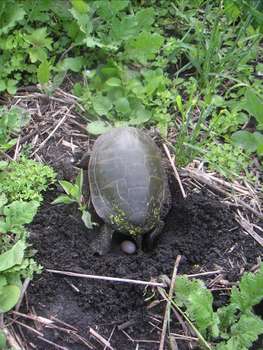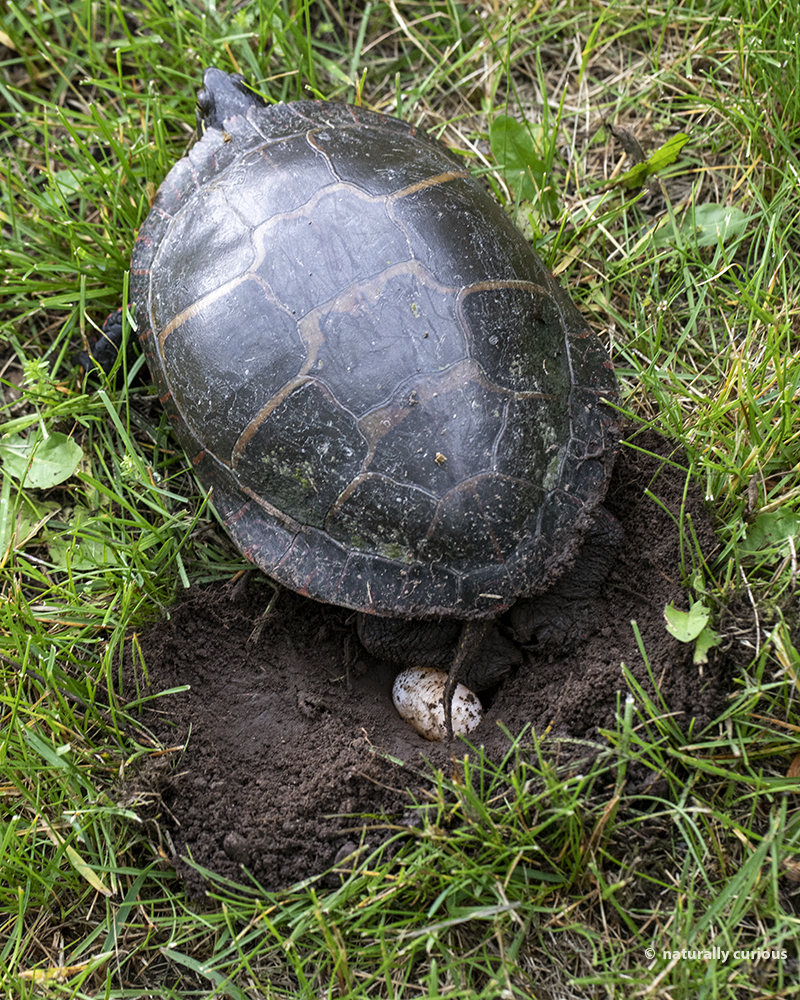A painted turtle typically lays around 5 to 12 eggs in a single clutch. These turtles are known for their small clutch sizes compared to other turtle species.
Painted turtles are commonly found in ponds, lakes, and slow-moving streams across north america. Painted turtles, scientifically known as chrysemys picta, are native to north america and are widely distributed across the continent. They are relatively small-sized turtles, with an average length of about 4 to 10 inches.
These turtles have distinctive reddish, yellow, and black markings on their smooth shells, making them easily recognizable. During the breeding season, which usually occurs in the spring or early summer, female painted turtles leave the water and search for suitable nesting sites. They prefer sandy or loose soil near water bodies where they can dig their nests. Once the nest is prepared, the female painted turtle lays a clutch of eggs. The number of eggs in a clutch typically ranges between 5 and 12, although occasionally larger clutches may be observed. The exact number of eggs laid can vary depending on factors such as the female’s age, size, and overall health. After the eggs are laid, the female covers them with soil and returns to the water, leaving the eggs to hatch on their own. The incubation period can last anywhere from 9 to 18 weeks, depending on various environmental conditions such as temperature and humidity. When the eggs hatch, the baby turtles, known as hatchlings, make their way to the water, guided by the reflection of light on the water’s surface. They are born with a small, specialized egg tooth called a caruncle, which they use to break through the shell. Once in the water, the hatchlings face numerous challenges as they start their journey of survival. They are particularly vulnerable to predators such as birds, fish, and larger turtles. However, those that manage to evade these threats have a relatively long lifespan, with some painted turtles living up to 30 years or more. A painted turtle typically lays around 5 to 12 eggs in a clutch, with the exact number depending on various factors. These small clutches contribute to the overall population of painted turtles, ensuring their continued presence in north american water ecosystems.

Credit: fmr.org
Understanding Painted Turtles And Their Egg-Laying Habits
Understanding the fascinating species of painted turtles and their egg-laying habits is a captivating topic. Painted turtles, known for their vibrant shell patterns, have unique characteristics when it comes to reproduction. These turtles have a specific habitat and behavior that play a crucial role in their egg-laying process.
Their habitat includes freshwater bodies such as ponds, lakes, and slow-moving streams. Painted turtles are excellent swimmers and often bask on logs or rocks to regulate their body temperature. It is fascinating to note that female painted turtles can lay around 3 to 20 eggs in a single clutch.
These eggs are buried in the sand or soil, where they undergo a lengthy incubation period before hatching. The reproductive behavior of painted turtles showcases the wonders of nature, providing a glimpse into the intricacies of their life cycle.
Factors Affecting Painted Turtle Egg Production
Factors such as environmental conditions greatly influence the egg production of painted turtles. The temperature plays a crucial role in their egg-laying process. Additionally, nesting sites also have a significant impact on the overall production of eggs by these turtles.
Proper temperatures are essential for ensuring successful laying and hatching of eggs. Suitable nesting sites offer protection and safety to the eggs. Painted turtles rely on these factors to determine the number of eggs they produce in a single clutch.
By understanding the influence of temperature and the importance of nesting sites, we can help conserve and protect the painted turtle population. It is vital to create and maintain favorable conditions to ensure the continued reproduction of these magnificent creatures.
The Egg-Laying Process Of Painted Turtles
The painted turtle, an iconic species found throughout north america, has a fascinating egg-laying process. These turtles carefully select suitable nesting areas that provide the right conditions for their eggs to develop successfully. Once they find a suitable spot, they begin the process of digging the nest, creating a protective egg chamber.
It’s quite intriguing to observe these turtles as they excavate the soil and make a cozy space for their eggs. After the nest is complete, the female turtle lays her eggs one by one, carefully positioning them within the nest.
This ensures that each egg has the best chance of survival. The entire egg-laying process of the painted turtle is a natural marvel that highlights the impressive instincts of these reptiles.
The Quantity Of Eggs Laid By Painted Turtles
Painted turtles, a common species, lay a variable number of eggs. Several factors influence the quantity of eggs they lay. Different painted turtle species have varying egg-laying patterns. Examining the average clutch size entails a detailed analysis and considering multiple variables.
By carefully considering these factors, we can gain insights into the reproductive behavior of painted turtles.
Survival Rates And Hatchling Success
Survival rates and hatchling success depend on predators and challenges faced by painted turtle eggs. Incubation periods and hatching success rates play a crucial role. Environmental factors have a significant impact on the survival of painted turtle hatchlings. Temperature, moisture, and nest location affect the development and emergence of the eggs.
Natural predators like raccoons, skunks, and birds pose a constant threat. Rising temperatures due to climate change can alter the sex ratios of hatchlings. Increased nest predation and habitat loss further decrease the chances of survival for painted turtle eggs.
Despite these challenges, painted turtles have evolved to maximize their reproductive success. Understanding the factors affecting turtle hatchling survival is vital for conservation efforts and ensuring the long-term survival of these fascinating creatures in their natural habitats.
Conservation Efforts For Painted Turtle Populations
Conservation efforts for painted turtle populations include protecting nesting areas and preserving their habitats. It is important to safeguard these areas to maintain sustainable populations. Legislation and initiatives have been implemented to support the conservation of painted turtles. By doing so, we can ensure the long-term survival of these turtles and their ecosystems.
Protecting their nesting areas is crucial as it directly impacts their reproduction and overall population growth. Preserving their habitats is equally important as it provides them with suitable conditions for survival. Through these conservation efforts, we can contribute to the protection of painted turtles and maintain the delicate balance of their ecosystems.
Conclusion
Paint turtles are fascinating creatures that lay a surprisingly large number of eggs. Their ability to produce up to 25 eggs per clutch reflects their reproductive efficiency. Understanding this aspect of their life cycle is not only interesting, but also important for conservation efforts.
By monitoring the number of eggs laid by painted turtles, researchers can gain insights into their population dynamics and reproductive success. This information can help inform habitat management strategies and ensure the long-term survival of these captivating reptiles. If you happen to come across a painted turtle nesting site, be sure to observe from a respectful distance and let nature take its course.
We must continue to appreciate and protect these beautiful creatures so that future generations can also enjoy their presence in our natural world.






Leave a Reply